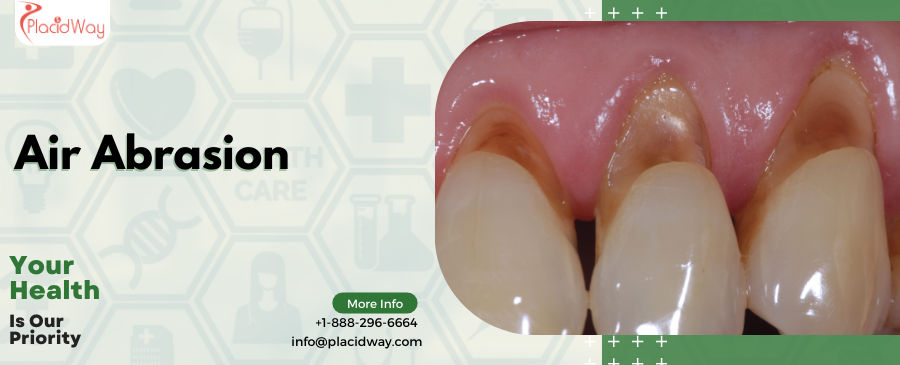
Discover Pain-Free Cavity Treatment: Your Guide to Air Abrasion Dentistry
The thought of a dental drill can send shivers down anyone's spine. The noise, the vibration, the potential discomfort – it’s a common source of dental anxiety for millions worldwide. But what if there was a gentler, quieter, and often pain-free way to treat cavities? Welcome to the world of Air Abrasion dentistry, a revolutionary "drill-less" technique that's changing the way we approach dental restorations.
For those seeking effective yet comfortable dental solutions, especially when considering dental tourism, Air Abrasion offers an appealing alternative. This innovative procedure uses a focused stream of tiny abrasive particles, propelled by compressed air, to gently remove decayed tooth structure without the need for a traditional dental drill. It’s perfect for treating small to moderate cavities, preparing teeth for bonding, or removing old composite fillings, often eliminating the need for local anesthesia.
Whether you're experiencing the early symptoms of a cavity – like increased tooth sensitivity to hot or cold, or a persistent dull ache – or simply looking for a less invasive way to maintain your oral health, Air Abrasion could be the answer. This comprehensive guide will explore everything you need to know about this advanced dental procedure, from understanding its benefits and eligibility to navigating international treatment options and cost comparisons. We'll help you understand why this modern approach is gaining popularity and how you can access world-class care through medical tourism.
What dental issues can Air Abrasion effectively treat?
Air Abrasion is an excellent solution for a specific range of dental problems, predominantly focusing on early-stage tooth decay. Patients often search for "drill-free cavity removal" or "pain-free dental fillings" when experiencing the following:
- Small to Moderate Cavities: This is the most common application. Air Abrasion is highly effective for removing decay that hasn't yet reached the inner pulp of the tooth. If you notice a tiny dark spot or a pit on your tooth that causes sensitivity when you eat sweets or hot/cold foods, it might be a small cavity that Air Abrasion can handle.
- Tooth Sensitivity: While sensitivity can have many causes, a new, small cavity can often trigger it. Air Abrasion can address the decayed area before it worsens.
- Preparation for Dental Bonding: Before applying composite resin to repair chipped teeth or close gaps, Air Abrasion can gently etch the tooth surface, creating an ideal base for strong bonding.
- Removal of Old Composite Fillings: It can be used to carefully remove failing composite (white) fillings without damaging the surrounding healthy tooth structure.
- Surface Stains and Discoloration: Air Abrasion can gently remove extrinsic stains, helping to brighten the tooth's appearance.
- Minor Tooth Preparation: In some cases, it can be used for minor preparation of teeth for veneers or crowns, though less common than for cavities.
If you're asking, "Do I have a cavity?" or "What are the early signs of tooth decay?", Air Abrasion offers a less intimidating treatment option compared to traditional drilling, especially for superficial lesions.
What causes cavities and who is at risk for tooth decay?
Cavities, medically known as dental caries, are tiny holes in your teeth caused by tooth decay. Understanding their origin is key to prevention and choosing the right treatment like Air Abrasion. Patients often search for "why do I get so many cavities?" or "what foods cause tooth decay?".
The primary culprits behind cavities include:
- Oral Bacteria and Plaque: Your mouth naturally contains bacteria. When you consume sugary or starchy foods and drinks, these bacteria feed on the carbohydrates and produce acids. These acids mix with bacteria, food particles, and saliva to form plaque – a sticky, colorless film that adheres to your teeth.
- Acid Attack on Enamel: The acids in plaque erode the hard outer layer of your tooth, the enamel. Over time, this erosion creates small holes, or cavities.
- Frequent Snacking/Sugary Diet: Constant exposure to sugars and starches, without adequate brushing, gives bacteria more fuel to produce acid, increasing the risk of decay.
- Poor Oral Hygiene: Infrequent or ineffective brushing and flossing allow plaque to accumulate and acids to continually attack your enamel.
- Dry Mouth (Xerostomia): Saliva helps neutralize acids, wash away food particles, and remineralize tooth enamel. A lack of saliva leaves your teeth more vulnerable to decay. Patients may ask "why is my mouth so dry?".
- Certain Medical Conditions and Medications: Some health issues or medications can reduce saliva flow or impact oral health, increasing cavity risk.
- Deep Pits and Grooves: Molars, with their intricate surfaces, can trap food particles and plaque, making them harder to clean and more susceptible to decay. This is why some seek "sealants for cavity prevention."
While anyone can develop cavities, certain groups are at higher risk, including children, teenagers, older adults (due to receding gums and dry mouth), and individuals with diets high in sugar, poor oral hygiene, or limited access to regular dental care. Understanding these factors is crucial for making informed decisions about treatment like Air Abrasion and preventing future decay.
How does Air Abrasion work and what are its unique benefits?
Air Abrasion is often referred to as "drill-less dentistry" for a good reason. Instead of the familiar whirring sound and vibration of a dental drill, this innovative technique employs a much gentler approach. Patients frequently search for "how does air abrasion work" or "benefits of no-drill dentistry."
How it works:
The Air Abrasion system uses a specialized handpiece that directs a fine stream of very small abrasive particles (typically aluminum oxide or silica) onto the tooth surface. This stream is propelled by compressed air or gas, gently "sandblasting" away the decayed tooth material. The dentist precisely controls the stream, targeting only the affected area, while a suction device simultaneously removes the abraded material and excess powder.
Unique Benefits of Air Abrasion:
- No Drill, No Pain (Often): This is the biggest draw. Without the heat, pressure, vibration, and noise of a traditional drill, many patients find the procedure comfortable enough to forgo local anesthesia, especially for small cavities. This is a huge relief for those with "dental phobia" or "fear of dentists."
- Preserves More Healthy Tooth Structure: Air Abrasion is highly precise, allowing the dentist to remove only the decayed portion of the tooth, leaving more healthy tooth structure intact. This leads to stronger, longer-lasting restorations.
- Quicker Appointments: With no need to wait for anesthesia to take effect and often a faster decay removal process, appointments can be significantly shorter. Patients looking for "fast dental treatment" often inquire about this.
- Reduced Risk of Chipping or Fracturing: The gentle nature of Air Abrasion reduces the risk of tiny fractures or chips that can sometimes occur with traditional drilling.
- Ideal for Children and Anxious Patients: The absence of the drill sound and vibration makes it much more tolerable for children and adults who experience dental anxiety. Parents often look for "gentle cavity treatment for kids."
- No Heat or Pressure: Unlike drills that can generate heat, Air Abrasion does not, minimizing discomfort and potential damage to the tooth's nerve.
- Allows Multiple Procedures: Since anesthesia might not be needed, multiple small cavities can often be treated in a single visit.
While not suitable for all types of cavities (e.g., very deep ones), for the right cases, Air Abrasion offers a significant step forward in patient comfort and minimally invasive dentistry.
Who is an ideal candidate for Air Abrasion dentistry?
While Air Abrasion offers many advantages, it's not universally applicable. Determining if you're a good fit involves a consultation with a dental professional. Patients often ask, "Can air abrasion fix my cavity?" or "Is air abrasion safe for children?".
You might be an ideal candidate for Air Abrasion if you:
- Have Small to Moderate Cavities: Air Abrasion is most effective for removing superficial to moderately-sized areas of decay. It excels in treating cavities on the biting surfaces (occlusal) and between the teeth (interproximal) if easily accessible.
- Experience Dental Anxiety or Phobia: If the sound or feel of a dental drill causes you significant stress or fear, the quiet, gentle nature of Air Abrasion can be a game-changer. It's often called "anxiety-free dental treatment."
- Prefer Minimally Invasive Dentistry: If you value preserving as much healthy tooth structure as possible, Air Abrasion's precision makes it an excellent choice.
- Are a Child or Teenager: Children often react very positively to Air Abrasion because it avoids the scary needle and drill. It's a popular option for "first cavity treatment for kids."
- Need Old Composite Fillings Replaced: Air Abrasion can efficiently and gently remove old composite (tooth-colored) fillings.
- Are Concerned About Anesthesia: For many procedures, anesthesia might not be needed, which is beneficial for those who have adverse reactions or simply prefer to avoid it.
When Air Abrasion might NOT be suitable:
- Deep Cavities: If the decay has reached the pulp (nerve) of the tooth or is very close to it, traditional drilling may be necessary for complete removal.
- Cavities Affecting Multiple Tooth Surfaces: Very extensive decay may require a more robust removal method.
- Old Amalgam (Silver) Fillings: Air Abrasion is not designed to remove metal fillings effectively.
- Patients with Respiratory Problems: While suction is used, a fine dust is created. Patients with severe asthma or other respiratory conditions might need to discuss alternatives.
- Lack of Isolation: To be effective, the area needs to be kept dry and isolated from saliva.
A thorough dental examination, including X-rays, will help your dentist determine if Air Abrasion is the right treatment for your specific needs.
What is the typical recovery process after Air Abrasion treatment?
One of the most appealing aspects of Air Abrasion dentistry is its remarkably easy and quick recovery process. Patients often search for "air abrasion aftercare" or "what to expect after drill-less filling."
Here’s what you can generally expect:
- Immediate Return to Normal Activities: Since anesthesia is often not used or wears off quickly if applied, you typically won't experience post-procedure numbness. This means you can eat, drink, and speak normally almost immediately after your appointment.
- Minimal Discomfort: Most patients report little to no pain or discomfort during and after Air Abrasion. The absence of the drill means no lingering aches from vibration.
- Temporary Sensitivity: It is common to experience some minor, temporary sensitivity to hot or cold temperatures in the treated tooth. This usually subsides within a few hours to a day or two as the tooth adjusts to the new filling. Over-the-counter pain relievers can help if needed.
- Gum Irritation: Occasionally, the abrasive particles can cause minor, temporary irritation to the surrounding gum tissue. This is typically very mild and resolves quickly.
- Post-Procedure Care: Your dentist will place a tooth-colored composite resin filling after the decay is removed. You should follow standard post-filling instructions, such as avoiding very hard or sticky foods for a short period if advised, and maintaining excellent oral hygiene.
- No Special Diet Restrictions: Unless otherwise instructed by your dentist, you can usually resume your normal diet immediately.
Compared to traditional drilling, which can sometimes lead to prolonged numbness, soreness, or even mild jaw discomfort, Air Abrasion offers a significantly smoother and faster recovery, making it an excellent choice for those with busy schedules or seeking "quick dental recovery."
Are there any risks or side effects associated with Air Abrasion?
Like any medical procedure, Air Abrasion carries some potential, though generally minor, risks and side effects. However, it is widely considered a very safe and conservative treatment. Patients often search for "is air abrasion safe?" or "air abrasion complications."
Here are the primary considerations:
- Temporary Tooth Sensitivity: As mentioned in recovery, some patients may experience mild, temporary sensitivity to temperature changes. This is usually transient and resolves on its own.
- Minor Gum Irritation: The abrasive particles, despite careful application, can sometimes cause very minor and temporary irritation to the surrounding gum tissue.
- Dust/Particle Exposure: A fine dust of abrasive particles is created during the procedure. Dentists use strong suction to minimize this, and patients are typically given protective eyewear. While rare, inhaling excessive dust could be a concern for individuals with severe respiratory conditions (e.g., severe asthma). This is why patient selection is important.
- Incomplete Decay Removal: For very deep or extensive cavities, Air Abrasion may not be able to completely remove all decay, potentially necessitating a switch to traditional drilling or another method.
- Not for All Fillings: It cannot be used to remove amalgam (silver) fillings or for preparing teeth for crowns that require significant structural changes.
- Pulp Exposure Risk (Rare): If the decay is much deeper than anticipated, there's a very slight risk of exposing the tooth's pulp, which would then require root canal treatment. This risk is generally lower than with traditional drilling due to the precision of Air Abrasion.
It's important to note that many risks associated with traditional drilling, such as cracks or fractures from vibration, and nerve irritation from heat, are significantly reduced or eliminated with Air Abrasion. Your dentist will assess your specific case and discuss any potential risks during your consultation, ensuring you are a suitable candidate.
How much does Air Abrasion cost worldwide?
One of the most compelling reasons individuals consider medical tourism for dental procedures like Air Abrasion is the significant cost savings available in different countries. Patients frequently search for "air abrasion cost USA," "dental tourism prices," or "affordable drill-less fillings abroad."
The price of Air Abrasion depends on several factors:
- Geographic Location: Costs vary dramatically from country to country due to differences in living expenses, labor costs, regulatory environments, and dental practice overheads.
- Number of Teeth Treated: The more cavities treated, the higher the overall cost.
- Complexity of the Case: While Air Abrasion is for small to moderate cavities, very challenging access or multiple surfaces can influence the price.
- Type of Filling Material: The cost of the composite resin filling placed after Air Abrasion also contributes to the total.
- Dentist's Experience and Clinic Reputation: Highly experienced dentists or premium clinics might charge more.
Here's an estimated cost comparison for Air Abrasion per tooth (excluding the filling material, which is usually an additional cost, though some clinics bundle):
| Country | Estimated Cost Range (USD) per Tooth | Notes |
|---|---|---|
| USA / Canada | $200 - $400+ | Higher operational costs, often covered partially by insurance. |
| Mexico | $100 - $250 | Popular for border towns; high-quality care often available. |
| Costa Rica | $150 - $300 | Known for excellent dental tourism infrastructure and experienced dentists. |
| Turkey | $100 - $200 | Emerging dental tourism hub with modern clinics. |
| Thailand | $100 - $250 | Combines dental treatment with popular vacation destinations. |
| Hungary | $120 - $280 | Long-standing reputation for high-quality, affordable dentistry in Europe. |
These figures are estimates and can vary. Many international clinics offer packages that include the Air Abrasion treatment and the composite filling. It's always best to get a detailed quote directly from the clinic or through a medical tourism facilitator like PlacidWay, who can provide transparent pricing and compare options.
Why should I consider Air Abrasion treatment abroad?
For a growing number of patients, seeking dental care like Air Abrasion beyond their home borders has become an increasingly attractive option. When asking, "Is dental tourism worth it?" or "Why travel for dental work?", several factors stand out:
- Significant Cost Savings: This is often the primary driver. As seen in the cost comparison, procedures can be 50-70% less expensive in popular dental tourism destinations compared to Western countries. This allows patients to get necessary treatments that might otherwise be unaffordable.
- Access to Advanced Technology and Expertise: Many international clinics invest heavily in state-of-the-art equipment and employ highly trained dentists, often educated in the US or Europe. You might find clinics abroad that offer advanced techniques like Air Abrasion more readily than some local practices.
- No Waiting Lists: In some countries, public healthcare systems can have long waiting lists for dental procedures. Traveling abroad often means you can schedule your treatment much sooner, avoiding prolonged discomfort.
- High-Quality Standards: Reputable dental tourism clinics are often accredited internationally and adhere to stringent quality and safety protocols, sometimes exceeding those found at home.
- Opportunity for a Vacation: Combining your dental treatment with a holiday (dental vacation) is a huge draw. You can recover in a beautiful, relaxing environment, turning a necessary procedure into an enjoyable experience.
- Privacy and Discretion: Some individuals prefer the privacy of having certain procedures done away from their local community.
When researching, patients often look for "best dental clinics abroad" or "international dental treatment options." The value proposition of combining high-quality, affordable dental care with the cultural experience of travel is a powerful one.
Which countries offer the best value and quality for Air Abrasion travelers?
Choosing the right destination for your Air Abrasion treatment is crucial. Patients typically search for "top dental tourism destinations," "affordable dental work in Mexico," or "best clinics for dental treatment in Turkey." Here are some of the leading countries known for offering excellent value and quality in dental tourism:
- Mexico: A long-standing favorite, especially for North Americans, due to its proximity and highly competitive pricing. Cities like Tijuana, Cancun, and Los Algodones (often called "Molar City") boast numerous modern dental clinics with English-speaking staff and US-trained dentists.
- Costa Rica: Known for its high standards of dental care, beautiful scenery, and eco-tourism. Costa Rica attracts patients seeking a relaxing recovery environment alongside advanced dental procedures.
- Turkey: An emerging powerhouse in medical tourism, offering state-of-the-art clinics, often in major cities like Istanbul and Antalya. Turkey provides a unique blend of cultural experiences with very affordable, high-quality dental care.
- Hungary: Especially popular among European patients, Hungary (particularly Budapest) has a long and respected tradition of dental excellence. Its dentists are renowned for their skill, and prices are significantly lower than in Western Europe.
- Thailand: Combining world-class medical facilities with exotic vacation opportunities, Thailand is a top choice for patients from Asia, Australia, and beyond. Bangkok and Phuket offer numerous accredited dental clinics.
When selecting a destination, consider factors beyond just cost, such as the clinic's accreditation, the dentist's qualifications and experience with Air Abrasion, patient reviews, language barriers, and ease of travel. A reputable medical tourism facilitator can guide you through these choices.
What should I know about safety, quality, and patient experiences when seeking Air Abrasion abroad?
Navigating international dental care requires careful planning and due diligence. Patients often search for "how to choose a dental clinic abroad," "safety of dental work in [country]," or "patient reviews for medical tourism."
What to Expect When Traveling for Air Abrasion:
- Pre-Travel Consultation: Many clinics offer online consultations where you can send X-rays and photos to get an initial assessment and treatment plan, along with a cost estimate.
- Travel Arrangements: You'll need to arrange your flights, accommodation, and local transportation. Many facilitators offer package deals.
- Clinic Visits: Upon arrival, you'll have an in-person consultation, usually followed by the Air Abrasion treatment and filling. The efficiency of the procedure often means quick visits.
- Recovery and Follow-up: Since Air Abrasion has minimal recovery, you can often enjoy your trip after treatment. Post-procedure care instructions will be provided.
- Communication: Most reputable clinics catering to international patients have English-speaking staff or translators.
How to Ensure Safety and Quality Abroad:
- Accreditation: Look for international accreditations like Joint Commission International (JCI), which signify adherence to global healthcare standards. Local accreditations are also important.
- Dentist Qualifications: Verify the dentist's education, experience, and specialization in procedures like Air Abrasion. Many international dentists have Western training.
- Facility Standards: Research clinics that use modern technology, maintain high sterilization standards, and have positive patient reviews regarding cleanliness and equipment.
- Patient Testimonials and Reviews: Seek out real patient experiences. Websites like PlacidWay often feature detailed testimonials, before-and-after photos, and success stories from patients who have undergone Air Abrasion and other treatments abroad. These success stories often highlight not only the quality of care but also the positive overall experience and savings.
- Transparent Communication: Ensure the clinic provides clear treatment plans, costs, and information on potential risks.
- Medical Tourism Facilitator: Engaging with a reputable facilitator like PlacidWay can significantly simplify the process. They vet clinics, assist with logistics, provide quotes, and act as a liaison, ensuring a safer and smoother experience.
Many patients report highly positive experiences with Air Abrasion abroad, praising the blend of advanced care, compassionate dentists, and affordability. For example, a patient from the US might share how they saved thousands on multiple cavity treatments in Mexico, enjoying excellent results and a stress-free trip thanks to their chosen clinic and facilitator.
Take the Next Step with PlacidWay
Ready to explore treatment options abroad? Discover top clinics, compare prices, and get a free quote tailored to your needs with PlacidWay.
Dental Tourism | Cosmetic Dentistry | Implants | Root Canals | Dentures | Bridges | Orthodontics | Dental Holidays Abroad










Share this listing